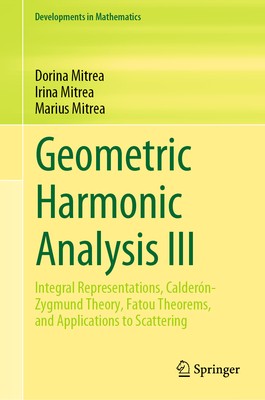
- We will send in 10–14 business days.
- Author: Dorina Mitrea
- Publisher: Springer
- ISBN-10: 3031227344
- ISBN-13: 9783031227349
- Format: 15.6 x 23.4 x 5.1 cm, kieti viršeliai
- Language: English
- SAVE -10% with code: EXTRA
Reviews
Description
This monograph presents a comprehensive, self-contained, and novel approach to the Divergence Theorem through five progressive volumes. Its ultimate aim is to develop tools in Real and Harmonic Analysis, of geometric measure theoretic flavor, capable of treating a broad spectrum of boundary value problems formulated in rather general geometric and analytic settings. The text is intended for researchers, graduate students, and industry professionals interested in applications of harmonic analysis and geometric measure theory to complex analysis, scattering, and partial differential equations.
Volume III is concerned with integral representation formulas for nullsolutions of elliptic PDEs, Calderón-Zygmund theory for singular integral operators, Fatou type theorems for systems of elliptic PDEs, and applications to acoustic and electromagnetic scattering. Overall, this amounts to a powerful and nuanced theory developed on uniformly rectifiable sets, which builds on the work of many predecessors.
EXTRA 10 % discount with code: EXTRA
The promotion ends in 23d.02:26:07
The discount code is valid when purchasing from 10 €. Discounts do not stack.
- Author: Dorina Mitrea
- Publisher: Springer
- ISBN-10: 3031227344
- ISBN-13: 9783031227349
- Format: 15.6 x 23.4 x 5.1 cm, kieti viršeliai
- Language: English English
This monograph presents a comprehensive, self-contained, and novel approach to the Divergence Theorem through five progressive volumes. Its ultimate aim is to develop tools in Real and Harmonic Analysis, of geometric measure theoretic flavor, capable of treating a broad spectrum of boundary value problems formulated in rather general geometric and analytic settings. The text is intended for researchers, graduate students, and industry professionals interested in applications of harmonic analysis and geometric measure theory to complex analysis, scattering, and partial differential equations.
Volume III is concerned with integral representation formulas for nullsolutions of elliptic PDEs, Calderón-Zygmund theory for singular integral operators, Fatou type theorems for systems of elliptic PDEs, and applications to acoustic and electromagnetic scattering. Overall, this amounts to a powerful and nuanced theory developed on uniformly rectifiable sets, which builds on the work of many predecessors.


Reviews